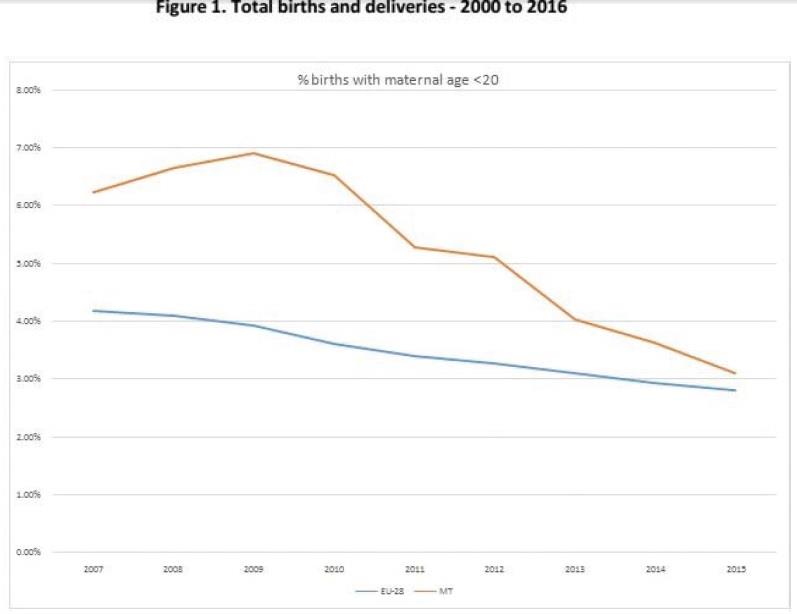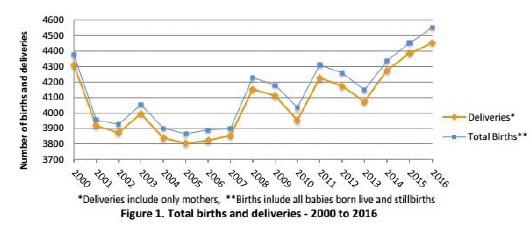The year 2016 saw a record 96 twins being born - 48 pairs - as well as a record number of total births in the delivery wards, according to the Directorate for Health Information and Research.
The National Obstetric Information System Annual Report for 2016, showed that, compared to 2015, there was an increase in the total number of births by 102 in 2016, resulting in a total number of 4,455 deliveries, of which 48 were twin deliveries and 2 were triplet deliveries.
The number of multiple deliveries has risen by 31 babies since 2015, and by 18 since 2010, where the previous record number of multiple deliveries in recent years stood at 80.
The report states that the increase was statistically significant with assisted reproductive technology (ART).
The total number of births in Malta has been on a steady inclination since 2013, prior to which it experienced a slight decline. The increase in births also comes with an increase in foreign mothers giving birth in Malta, how ever, the Directorate for Health Information and Research told The Malta Independent that it would be “incorrect” to say the latter is “totally responsible” for the former.

“Malta’s total number of births has been increasing over past years. So has the percentage of foreign mothers giving birth in Malta. To say that the latter is totally responsible for the former may, nonetheless, be incorrect. The number of births by Maltese mothers has also been creeping up over the years, albeit at a slower pace,” said Director Neville Calleja.
The percentage of deliveries to non-Maltese women was marked as 19.9 per cent in 2016, experiencing a steady inclination since 2000. Meanwhile, the percentage of deliveries to Maltese women has gone from around 95 per cent in 2000, to 80.1 per cent in 2016.
“The proportion of deliveries in mothers of non-Maltese nationality had increased from 19.1 per cent to 19.9 per cent between 2015 and 2016,” the report states.
When it comes to marital status, of all the deliveries, 1256 (28.2 per cent) of mothers were reported as never married, 3029 (68 per cent) were reported as married and 170 (3.8 per cent) were reported as being widowed, separated or divorced.

In 2016, 99.8% of the deliveries occurred in hospital, and 139 mothers registered as having made use of assisted reproduction, according to the report.
Out of the 4555 births, 2401 (52.7 per cent) were male and 2154 (47.3 per cent) were female.
Last week, The Malta Independent reported that the number of Maltese teenage mothers remains in decline, whilst the number of women having their first child in their 30’s continues to witness an increase, according to a new Eurostat report where research was taken in 2015.
A decade ago, in 2007, Malta saw 171 teenage first-time mothers, who fell into an age category of females younger than 20 years of age. In 2012, the number was down to 155 births, following which it dropped again to 114 in 2013, decreasing to 95 first-time mothers in 2015.
Charts provided by Calleja show that in 2009, almost seven per cent of births were to women under the age of 20, this decreased to less than three per cent in 2015. Calleja called this decrease a ‘dramatic’ one, “we do not have either any specific explanation for this decline,” he added.
Besides this decline, figures by Eurostat between the years 2007 and 2015 also show a shift in age as to when women are having their first child, with more women having children in their late thirties. Between 2007 and 2012, the majority of first born children belonged to mothers aged between 25 to 29 years of age. In 2013 and 2015, the majority of first borns shifted to the ‘30 to 34’ age group for the first time. The year 2014 saw an exception to the rule as it also marked the majority of first borns to mothers in the ‘25 to 29’ age group.
In the DHIR report, where the number of deliveries is taken note of, rather than the number of firsttime mothers, this also seems to be the case.
In 2016, the greatest number of deliveries, 1588 (35.6 per cent) occurred in the age group 30 to 34 years. The number of deliveries in the ‘25-29’, ‘30-34’, ‘35-39’, ‘40-44’ and ‘45+’ age groups all witness a slight increase.
When asked what could be causing this shift in age to be a first time mother, Calleja said the main reason is “that of choice.”
“This phenomenon is an international one and there is indeed a body of scientific literature about it. The main attributable reason appears to be one of choice - that women are choosing to delay childbirth in order to nourish a career or in order to have a more stable foothold in life before starting to have children,” he said.
“Whilst one understands these choices perfectly, the literature also describes the price of delaying childbirth, particularly in terms of fertility and a risk for more complications in pregnancy. In effect, the medical advancements that may be permitting later childbirth would probably be primarily those helping infertility which include IVF, but not only, as IVF is simply the last option in a string of treatments that are available for infertile couples.”